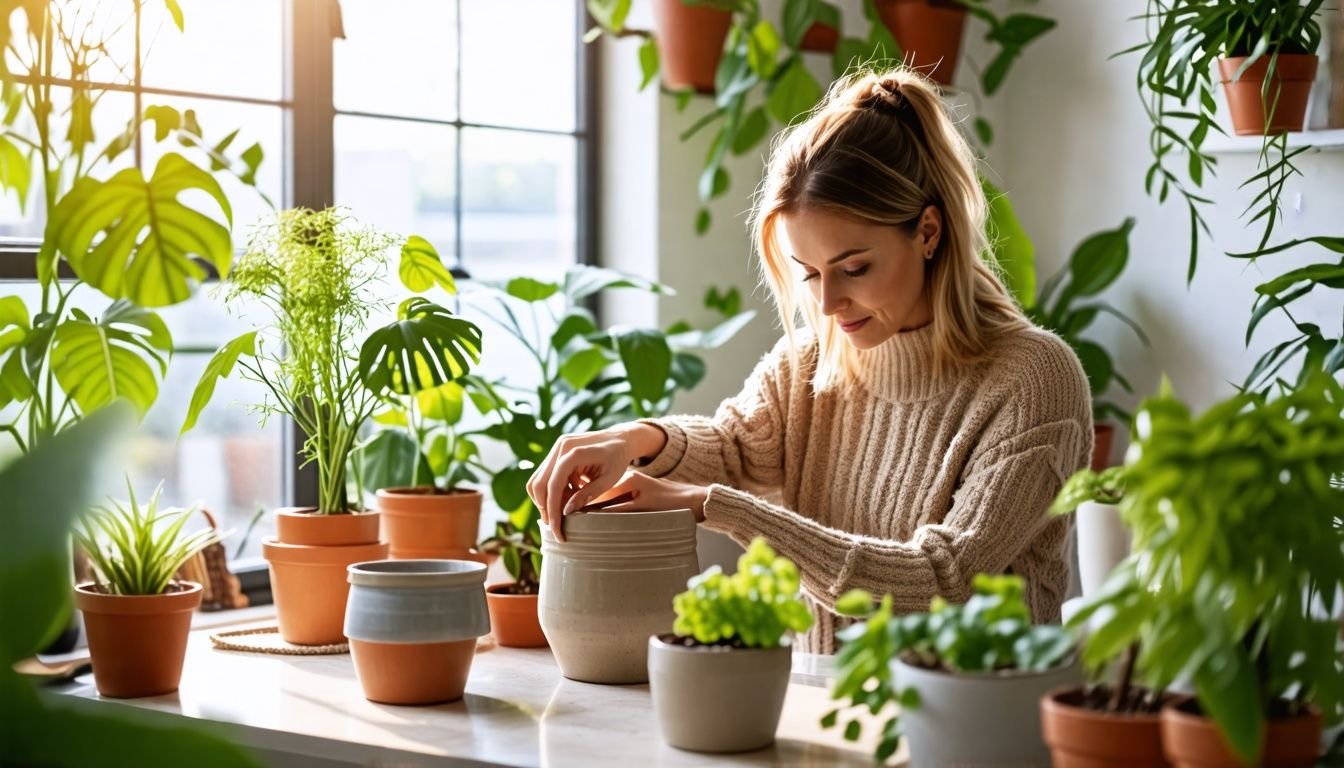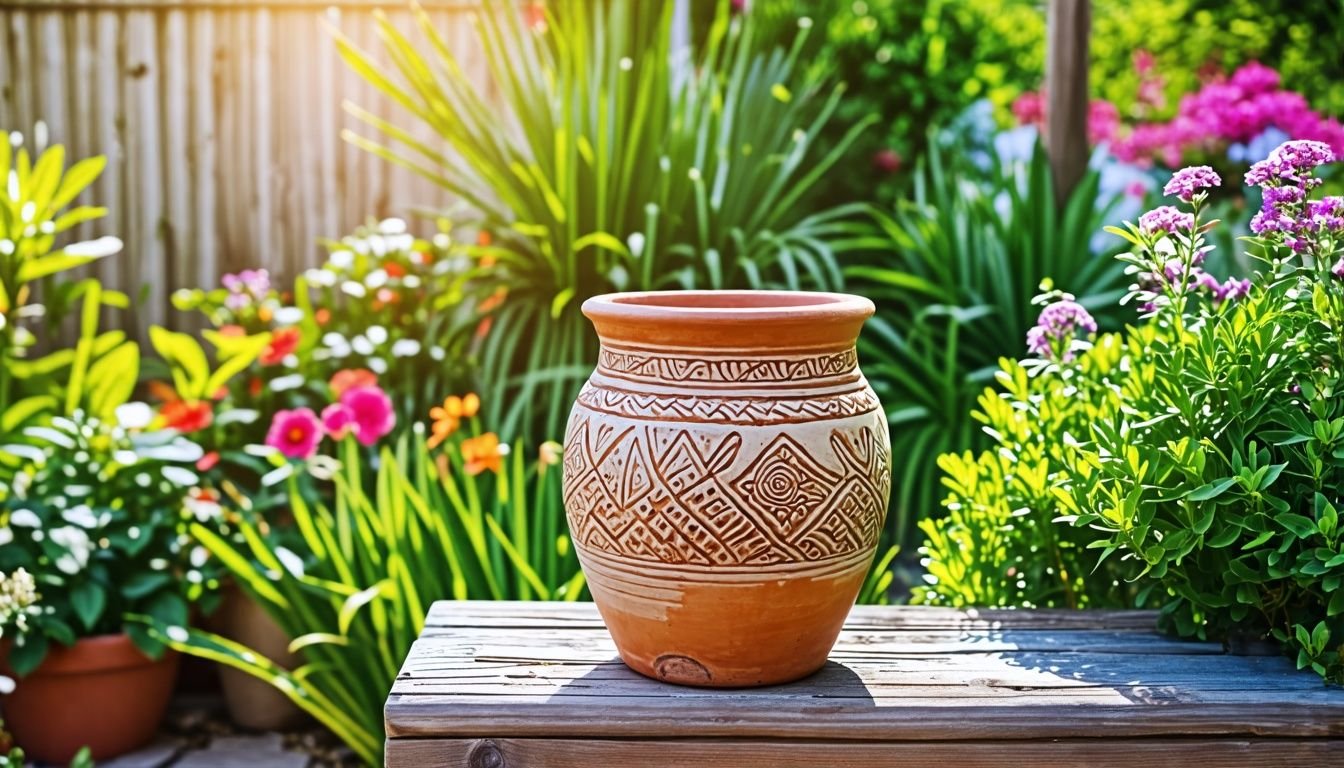G’day, mate! Are you having a hard time finding the perfect ceramic pot for your plants? We know how frustrating it can be to sift through heaps of options, only to end up with a pot that’s not quite right for your space or your plant’s needs.
It’s enough to drive you bonkers!
We’ve been down that road before, and we get how important it is to nail it. After doing our fair dinkum research, we reckon ceramic pots with drainage holes are crucial for keeping your plants happy and healthy.
They let excess water escape, which stops your plant’s roots from turning into mush.
Our digging around has uncovered some ripper tips for picking out the ideal ceramic pot for your home. We’ll walk you through everything you need to know about size, shape, drainage, and style, so you can make a choice you’ll be chuffed with.
Ready to give your space a facelift with the perfect pot?
Key Takeaways
- Choose a ceramic pot that’s about one-third the size of your available space to get the right balance.
- Drainage holes are crucial for keeping plants healthy by preventing waterlogged soil and root rot.
- Match pot shapes to plant types – tall pots for upright plants, shallow ones for succulents, and hanging planters for trailing plants.
- Pick colours and designs that complement your decor, like the versatile ID Planters by Jenn Johnston in Charcoal, Eggshell White, Speckled, and Caramel.
- Texture and finish affect a pot’s look – smooth finishes offer a modern vibe, while textured surfaces add character and visual interest.
Assessing the Right Size and Shape for Your Space

Choosing the right size and shape for your ceramic pot is key. We’ll guide you through picking the perfect fit for your space and plant.
Consider the size of the area where the pot will be placed
We always start by sizing up the space where our new ceramic pot will live. It’s crucial to measure the area accurately, considering both width and height. A pot that’s too big can overwhelm a small corner, while one that’s too small might get lost in a spacious room.
We’ve found that a good rule of thumb is to choose a pot that takes up about one-third of the available space.
We love using recycled materials for outdoor pots, as they add character and sustainability to our gardens.
For outdoor areas like flower beds or spaces near christmas trees, we need to think about the pot’s proportions in relation to the surrounding plants. A larger pot can serve as a focal point, while smaller ones work well in clusters.
Our Mercury Hanging Planter by Buzzby & Fang comes in small, medium, and large sizes, perfect for various spaces. At $165.00, it’s a versatile option for both indoor and outdoor use.
For a more traditional look, the Terracotta ID Planter by Jenn Johnston, starting from $80.00, offers three size options to suit different areas in our homes or gardens.
Choose a shape that complements the plant type
Choosing the right shape for your ceramic pot is crucial to complement your plant’s growth habits. Tall, columnar pots suit upright plants like snake plants or cacti. Wide, shallow containers work best for succulents and other plants with shallow root systems.
For trailing plants such as pothos or string of pearls, hanging planters or tall pots with a wide rim are ideal.
We’ve found that matching pot shapes to plant types not only enhances aesthetics but also promotes healthy growth. Round pots soften the look of spiky plants, while angular containers add structure to flowing foliage.
Our Squiggy and Lenny planters from Buzzby & Fang, priced between $165 and $335, offer unique shapes that can elevate various plant types in your home.
A well-chosen pot shape can transform a simple plant into a living work of art.
For larger statement plants, consider the Devasa Spike Planter by Buzzby & Fang. Available in sizes from small to low wide medium, it provides ample space for root growth while making a bold design statement.
Let’s explore the importance of drainage in ceramic pots next.
Importance of Drainage in Ceramic Pots
Drainage is crucial for healthy plants. Good drainage prevents root rot and keeps your plants happy.
Understand the benefits of having drainage holes
We can’t stress enough how crucial drainage holes are for ceramic pots. These small openings at the bottom of the container play a big role in keeping our plants healthy. They allow excess water to escape, preventing waterlogged soil and root rot.
This is especially important for our Aussie gardens, where sudden downpours can quickly flood pots without proper drainage.
Drainage holes also promote better air circulation in the soil, which is vital for root health. They help maintain the right balance of moisture and oxygen, letting roots breathe and grow strong.
For our cut flowers and potted plants alike, this means healthier growth and longer-lasting blooms. Plus, these holes make it easier to spot when we’ve watered enough, as we’ll see the excess trickle out the bottom.
Options for pots without drainage holes
Ceramic pots without drainage holes can still be great for indoor plants. Here are some options to make them work:
- Use a layer of pebbles at the bottom. This creates a space for excess water to collect, away from the plant’s roots.
- Add activated charcoal. It helps absorb excess moisture and prevents mould growth.
- Choose plants that thrive in moist conditions. Ferns, peace lilies, and spider plants are good options.
- Water sparingly. Less frequent, deeper watering is better than frequent light watering.
- Use a plastic liner with holes. Place this inside the ceramic pot to allow for drainage.
- Employ the double pot method. Put a smaller pot with drainage holes inside the decorative ceramic pot.
- Add a layer of sand. This helps with water distribution and prevents waterlogging.
- Use a moisture meter. It helps you know when to water, avoiding overwatering issues.
- Opt for a well-draining potting mix. This allows water to move through the soil more easily.
- Consider using self-watering pots. These regulate moisture levels, reducing the risk of overwatering.
Aesthetic Considerations for Enhancing Your Home Decor
Ceramic pots can make a big impact on your home’s style. We’ll show you how to pick colours and designs that fit your space perfectly.
Selecting colours and designs that match your interior
We love how ceramic pots can transform a space. Choosing colours and designs that complement your interior creates a cohesive look. Our Charcoal, Eggshell White, Speckled, and Caramel ID Planters by Jenn Johnston offer versatile options.
These pots blend seamlessly with various decor styles, from modern to rustic.
For a more unique touch, we recommend the Brown Check, Blue x Orange Check, Blue Check, and Apricot Spotlines Wood Fired Planters by Sandra Bowkett. These artisanal pieces add character and warmth to any room.
Their handcrafted patterns create visual interest without overwhelming your existing decor. We find that mixing and matching different colours and designs can create a stunning display that reflects your personal style.
Impact of texture and finish on the overall look
Moving from colours and designs, let’s explore how texture and finish affect your pot’s appearance. Texture adds depth and interest to ceramic pots, creating visual appeal. Smooth finishes like those on our Minimalist Planters by Arcadia Scott offer a sleek, modern look.
These planters, available from $77.00, come in Chestnut, Lapis Lazuli, and Oatmeal shades.
For a more rustic feel, our Wing Bowl and Fluted Planters feature textured surfaces. Priced between $66.00 and $70.00, these pots add character to any space. The interplay of light on textured surfaces creates shadows and highlights, enhancing the pot’s visual impact.
Matte finishes absorb light, giving a soft, understated look, while glossy finishes reflect light, making pots appear more vibrant and eye-catching.
Visit Our Collection for More Inspiration (link to https://bindy. com. au/)
We’ve curated a stunning collection of handmade ceramic planters at Bindy. Our range showcases unique designs, vibrant colours, and various sizes to suit every plant and home décor style.
From sleek modern pots to rustic earthenware, we offer options for all tastes.
A well-chosen pot can transform a simple plant into a living work of art.
Our website features high-quality images and detailed descriptions of each planter, making it easy to find your perfect match. Browse our collection today and discover the ideal ceramic pot to elevate your indoor garden.
Next, we’ll wrap up with some final thoughts on selecting the perfect ceramic pot for your home.
Conclusion on Choosing the Perfect Ceramic Pot
Selecting the right ceramic pot enhances your plant’s health and your home’s style. Your choice should blend function and aesthetics, considering size, drainage, and decor. A well-chosen pot becomes a stunning focal point in any room.
Our tips guide you to find the perfect match for your green friends. Remember, the ideal pot brings joy to both you and your plants.
FAQs
1. What size ceramic pot should I choose for my plant?
Choose a pot that’s about 2-3 cm wider than your plant’s current container. This gives roots room to grow.
2. How do I know if a ceramic pot has good drainage?
Look for drainage holes at the bottom. If there aren’t any, drill some yourself. Good drainage prevents root rot.
3. What colour ceramic pot works best for indoor plants?
Pick a colour that complements your home decor. Light colours reflect light, while dark ones absorb it. Consider your plant’s light needs.
4. Are glazed or unglazed ceramic pots better for plants?
Both work well. Glazed pots hold moisture longer. Unglazed ones allow air flow. Choose based on your plant’s water needs.
